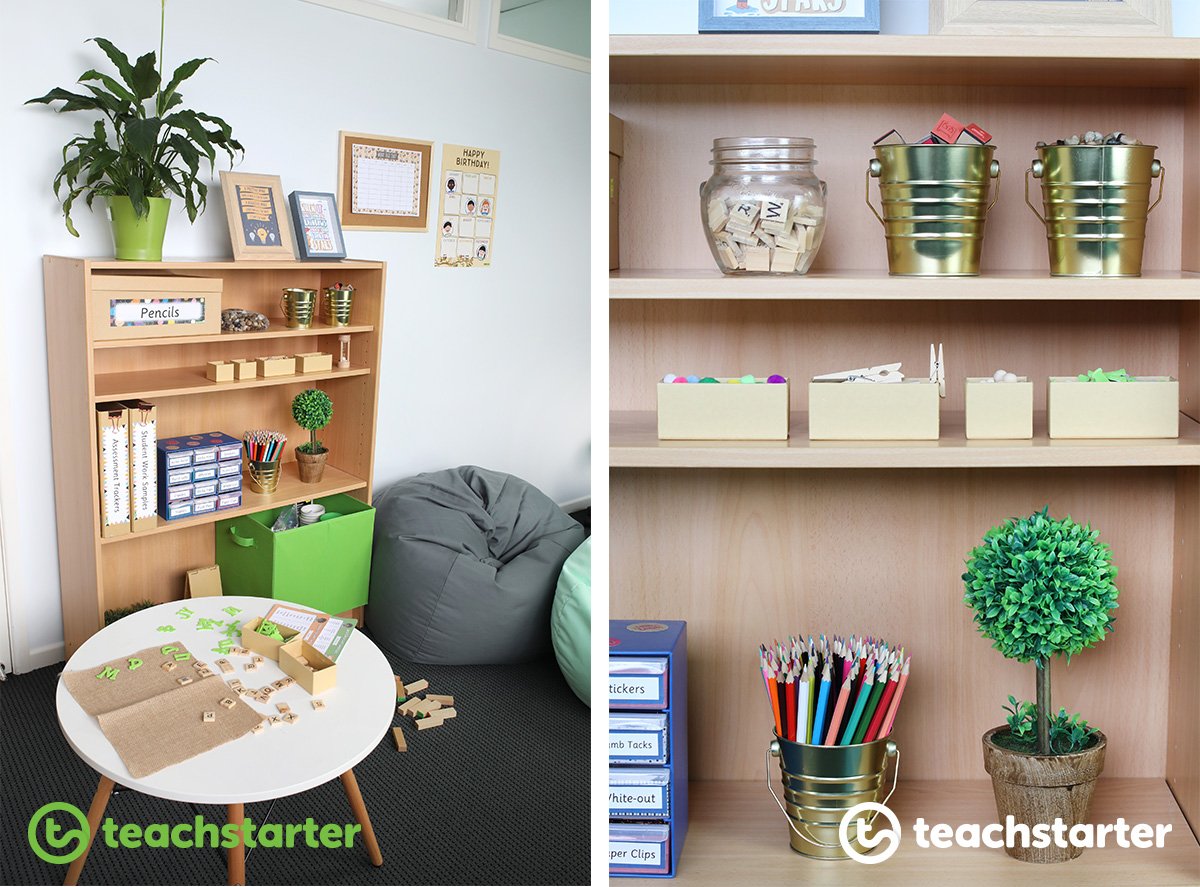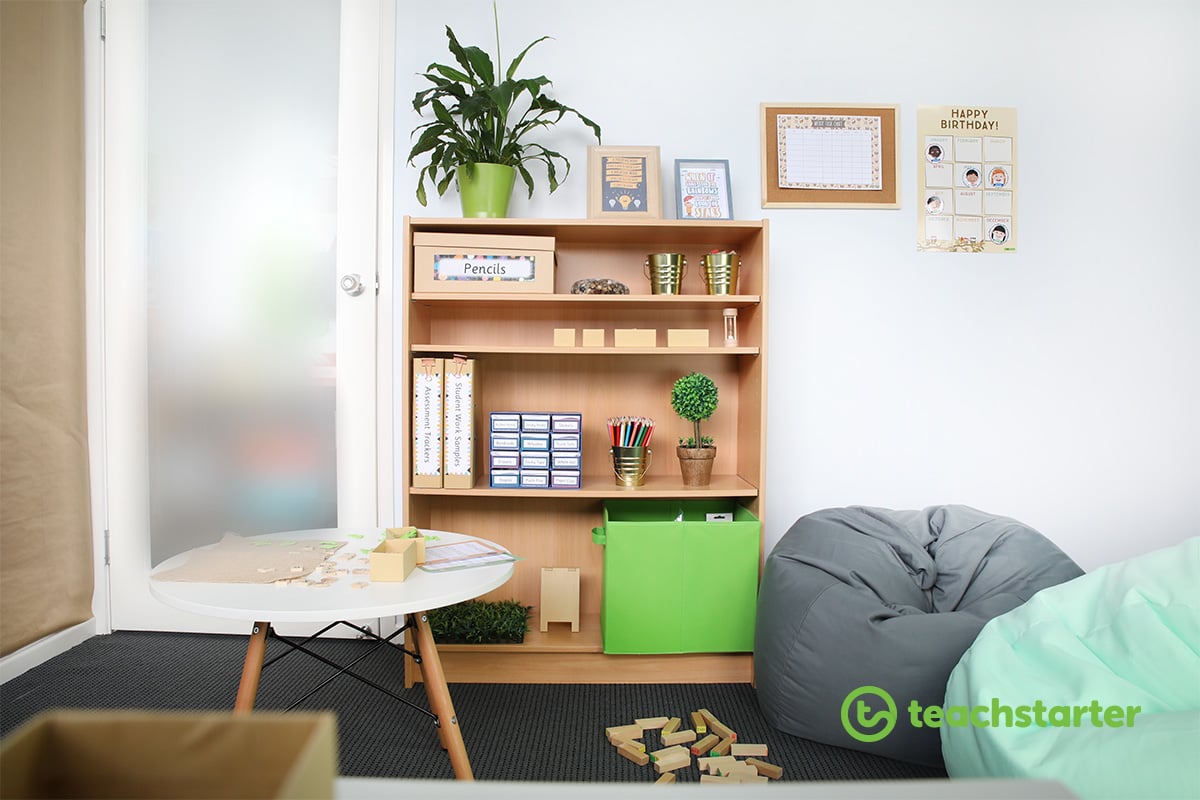Oh, happy day! It’s almost the end of the year. Which means out with the old and in with the new, right? Maybe not. When it comes to the perfect end of year classroom clean out, the “old or new” classification isn’t always such a useful one! Instead, you need a simple way to think about cleaning out your classroom and we have 5 simple decluttering tips for teachers to make this easy for you!
To start, get yourself set up with four large containers:
- one for recycling
- one for giveaways
- one for items that need to find a new home, outside of your classroom
- one for rubbish.
Tip #1 – Sort by Category, Not Location
Queen of decluttering, Marie Kondo has more than a few fabulous decluttering tips in her book “The Life-Changing Magic of Tidying Up”. But before you go and spend the next few hours reading, here’s the one that we think is the most useful to teachers.
Sort through your classroom by category, not location.
The “Konmari method” of decluttering would have you working through your home in categories. E.g. clothes, books and documents, miscellaneous and sentimental items. We’d suggest the same for your classroom…
…beginning with the categories that are least sentimental to you.
Here are some categories you might find in your classroom:
- mathematics equipment, resource and games
- literacy resources and games
- other KLA resources and games
- class readers or classroom library books
- board games
- printed programs, lessons plans and syllabus documents
- meeting and professional development notes
- themed decorations
- display items – posters, labels etc.
- sports equipment
- stationery
- art and craft supplies.
Write them up on your board in the order that you’ll work through them. And then, proceed to the step below!
Tip #2 – Use It or Lose It!
Lay out everything you have in a single category.
You need to approach your classroom clean out with a clear set of boundaries.
It’s time to get tough with yourself and those persistent “I might use this for something later” tendencies!
Consider each item. If it falls into one of the categories below put it into one of your boxes (recycling, giveaway, relocate, rubbish).
- You didn’t use it this year
- It’s broken or incomplete
- It’s out of date
- It’s not something that you need.

Tip #3 Not Many, If Any
If you’re having trouble letting go of some of the older bits and pieces that were handed down from the classroom teacher before you, try reframing that those feelings by asking yourself one of the following questions:
- How many of that type of resource/object/book do you actually need for your class to function as it does throughout the school year? If you have enough, then it’s time to realise that the older, damaged, half-used or out-dated items have served their purpose to many kids in the past and they can be let go!
- How much that object/book/resource is worth right now if you were to sell it second-hand? Ask yourself “If I didn’t already have this item/book/resource, would I be willing to pay that for it?”
Tip #4 – Host a Teacher Swap Party!
You might really enjoy hosting a resource/stationery/teacher resource swap party with teacher friends!!
Like clothes swap but waaaay better.
Invite your teaching buddies and provide them with the following instructions:
- Bring resources, books, stationery that you no longer use, but that are in good enough condition that IF you did need one, you’d buy it off the shelf for yourself.
- Bring a plate of deliciousness to share.
- Bring a beverage or two that will make you smile.
You might find that some of your friends who work with age-groups different to yours have been hoarding something that would be wonderful for you to use with your kids, and visa versa! It is a fantastic way to reduce the amount of waste generated by your classroom clean out, as well as limiting the new products you might purchase in order to get some new resources for your students.
Tip #5 – Stick it
Hands up if you’ve heard of the old wardrobe decluttering trick of hanging your clothes hangers in the reverse direction? Each time you wear a piece of clothing, you hang it back the right way. Then at the end of six or twelve months, you’ll be able to see what you have actually worn and which items of clothing you haven’t touched in that time.
Non-Paper Items
Sticky dots are one way you can implement a similar process with physical items in your classroom. Place a sticky dot on each item or container. When you use the item, take off the sticky dot. Next time you go through your classroom, items that still have their sticky dots are likely to be ones you don’t need to keep anymore.
Paper Items
If you have a large number of printed resources stored in filing cabinets (likely filed by year level and/or KLA) this tip is for you!
If you have space, keep the top drawer of your filing cabinets empty and move all of your paper files and folders to the bottom drawers. Each time you use a printed resource, put it back into a new folder in the top drawer. At the end of the year, you’ll see which resources you’ve actually used in your planning and teaching. This helps you decide if you can recycle the rest of the unused printed resources.

What to do with it all?
So, now you’ve got a whole lot of things that need to make a journey out of your classroom to make space for your mind, space for the resources you actually use, and space for your students to learn! But what to do with it all? Being aware of your environmental footprint is so important, and can be a great future motivator to help you reduce the amount of ‘stuff’ that you bring into your classroom.
Sell or Giveaway
If it’s something that you’d buy in its current condition, that you know has a value to others, consider selling it second-hand, or giving it away.
Recycle
Provided the papers you have for recycling do not contain personal or sensitive information, make sure they end up in a recycling bin!
Did you know that you don’t need to remove staples for paper to be recycled?
Reduce
After all of this, hopefully, you’ll have a slightly different perspective when it comes to the items you bring into your classroom. Not only does each item we create and consume need to have a ‘home’, which adds to the year-long clutter build in your room, but we must be aware of the environmental impacts of everything too!
Do you do an end of year classroom clean out?
Share your top tips in the comments below?







Comments